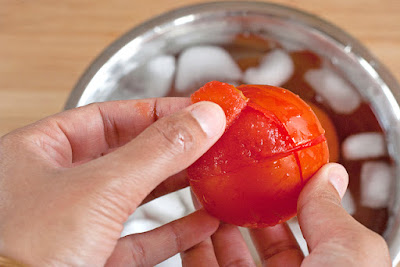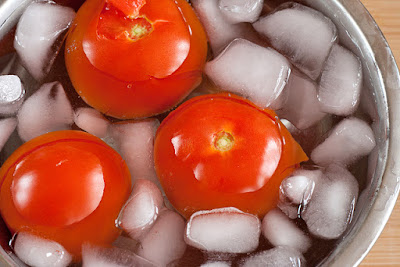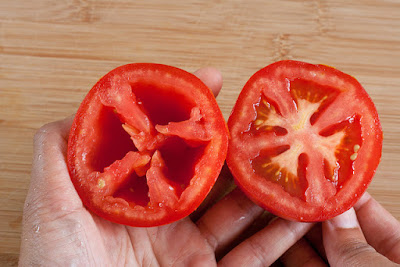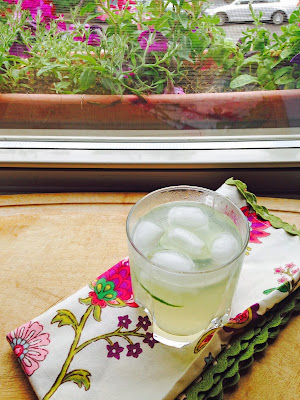In Illinois, midsummer is ushered in with the flash of fireflies and the
radioactive buzz of cicadas looking for love. Fuzzy-faced sunflowers
tower over Queen Anne’s lace and Black-eyed Susans. In the kitchen, the
spotlight shifts from sweet corn to vine-ripened tomatoes, which spruce up
salads, top backyard burgers, and stud my mom's one-of-a-kind Tomato Rice.
How to Select Tomatoes
Select tomatoes that are wrinkle-free and feel weighty in your palm. When given a gentle squeeze, the fruit should feel soft, but not squishy. Since ripe tomatoes have a relatively short shelf life, try to gobble them up as quickly as possible. If you end up with a surplus, store them at room temperature in a single layer. Avoid chilling them in the refrigerator as it makes their lush flesh grainy.
How to Peel Tomatoes
Tomatoes must be peeled (and seeded) to produce bisque and other silky, smooth dishes. It’s a simple process that can also be used to skin peaches and other stone fruit.
Hold the tomato with the bottom side facing up. With a sharp chef’s, paring, or serrated knife, cut an "x" in the skin. Repeat with the rest of the tomatoes.
Fill a large bowl with water and ice and set it aside.
Bring a large pot of water to a boil. Carefully lower each tomato into the boiling water, using tongs or a deep ladle. After 45 seconds, transfer each tomato to the ice water bath to stop the cooking.
Peel away the skins, beginning at the cross of the "x."
 How to Remove Seeds from Tomatoes
How to Remove Seeds from Tomatoes
Slice the tomato (peeled or not) in half width wise. Hold one half of the tomato over a bowl. Use your thumb and index finger to gently force out the seeds.
If the seeds cling to the flesh, gently tap the tomato against the cutting board, cut side down.
How to Slice Tomatoes
The first step in slicing tomatoes is removing the core. Although it’s commonly done with a paring knife, I like the idea of removing it with a thin-edged measuring spoon as it’s a bit safer (making it a good job for kids).
Pierce and then encircle the flesh surrounding the stem end with a measuring spoon.
Place the tomato on its side on a cutting board, and then slice across the tomato width wise.
How to Chop Tomatoes
Remove the stem end with a measuring spoon, as illustrated above. Place the tomato on its side on a cutting board and slice it in half.
Place one half on the cutting board with the cut side down. Rest one hand on top of the tomato to hold it in place. With your other hand, hold the knife parallel to the cutting board and slice across the tomato.
Hold the knife perpendicular to the cutting board, and slice across the tomato.
Rotate the tomato 90 degrees. Hold the knife perpendicular to the cutting board and cut across the tomato again.
How to Prepare Tomatoes for Stuffing
Remove the core with a measuring spoon, as illustrated above. Place the tomato on its side on a cutting board and slice off the top quarter. Through the enlarged opening, carefully scoop out the ribs and seeds with a spoon.
How to Select Tomatoes
Select tomatoes that are wrinkle-free and feel weighty in your palm. When given a gentle squeeze, the fruit should feel soft, but not squishy. Since ripe tomatoes have a relatively short shelf life, try to gobble them up as quickly as possible. If you end up with a surplus, store them at room temperature in a single layer. Avoid chilling them in the refrigerator as it makes their lush flesh grainy.
How to Peel Tomatoes
Tomatoes must be peeled (and seeded) to produce bisque and other silky, smooth dishes. It’s a simple process that can also be used to skin peaches and other stone fruit.
Hold the tomato with the bottom side facing up. With a sharp chef’s, paring, or serrated knife, cut an "x" in the skin. Repeat with the rest of the tomatoes.
Fill a large bowl with water and ice and set it aside.
Bring a large pot of water to a boil. Carefully lower each tomato into the boiling water, using tongs or a deep ladle. After 45 seconds, transfer each tomato to the ice water bath to stop the cooking.
Peel away the skins, beginning at the cross of the "x."

Slice the tomato (peeled or not) in half width wise. Hold one half of the tomato over a bowl. Use your thumb and index finger to gently force out the seeds.
If the seeds cling to the flesh, gently tap the tomato against the cutting board, cut side down.
How to Slice Tomatoes
The first step in slicing tomatoes is removing the core. Although it’s commonly done with a paring knife, I like the idea of removing it with a thin-edged measuring spoon as it’s a bit safer (making it a good job for kids).
Pierce and then encircle the flesh surrounding the stem end with a measuring spoon.
Place the tomato on its side on a cutting board, and then slice across the tomato width wise.
How to Chop Tomatoes
Remove the stem end with a measuring spoon, as illustrated above. Place the tomato on its side on a cutting board and slice it in half.
Place one half on the cutting board with the cut side down. Rest one hand on top of the tomato to hold it in place. With your other hand, hold the knife parallel to the cutting board and slice across the tomato.
Hold the knife perpendicular to the cutting board, and slice across the tomato.
Rotate the tomato 90 degrees. Hold the knife perpendicular to the cutting board and cut across the tomato again.
How to Prepare Tomatoes for Stuffing
Remove the core with a measuring spoon, as illustrated above. Place the tomato on its side on a cutting board and slice off the top quarter. Through the enlarged opening, carefully scoop out the ribs and seeds with a spoon.

















